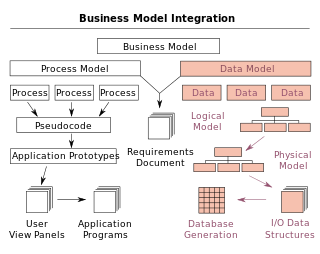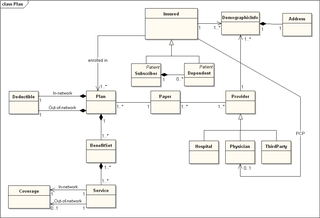Related Research Articles
In software engineering, multitier architecture is a client–server architecture in which presentation, application processing and data management functions are physically separated. The most widespread use of multitier architecture is the three-tier architecture.

Software architecture is the set of structures needed to reason about a software system and the discipline of creating such structures and systems. Each structure comprises software elements, relations among them, and properties of both elements and relations.
The facade pattern is a software design pattern commonly used in object-oriented programming. Analogous to a façade in architecture, it is an object that serves as a front-facing interface masking more complex underlying or structural code. A facade can:

A data model is an abstract model that organizes elements of data and standardizes how they relate to one another and to the properties of real-world entities. For instance, a data model may specify that the data element representing a car be composed of a number of other elements which, in turn, represent the color and size of the car and define its owner.
In software engineering, a Design Pattern describes a relatively small, well-defined aspect of a computer program in terms of how to write the code.
Software design is the process of conceptualizing how a software system will work before it is implemented or modified. Software design also refers to the direct result of the design process – the concepts of how the software will work which consists of both design documentation and undocumented concepts.
In computer science, separation of concerns is a design principle for separating a computer program into distinct sections. Each section addresses a separate concern, a set of information that affects the code of a computer program. A concern can be as general as "the details of the hardware for an application", or as specific as "the name of which class to instantiate". A program that embodies SoC well is called a modular program. Modularity, and hence separation of concerns, is achieved by encapsulating information inside a section of code that has a well-defined interface. Encapsulation is a means of information hiding. Layered designs in information systems are another embodiment of separation of concerns.
A modeling language is any artificial language that can be used to express data, information or knowledge or systems in a structure that is defined by a consistent set of rules. The rules are used for interpretation of the meaning of components in the structure of a programming language.
In software engineering, service-oriented architecture (SOA) is an architectural style that focuses on discrete services instead of a monolithic design. SOA is a good choice for system integration. By consequence, it is also applied in the field of software design where services are provided to the other components by application components, through a communication protocol over a network. A service is a discrete unit of functionality that can be accessed remotely and acted upon and updated independently, such as retrieving a credit card statement online. SOA is also intended to be independent of vendors, products and technologies.

In software engineering, a domain model is a conceptual model of the domain that incorporates both behavior and data. In ontology engineering, a domain model is a formal representation of a knowledge domain with concepts, roles, datatypes, individuals, and rules, typically grounded in a description logic.
Object-oriented analysis and design (OOAD) is a technical approach for analyzing and designing an application, system, or business by applying object-oriented programming, as well as using visual modeling throughout the software development process to guide stakeholder communication and product quality.
Domain engineering, is the entire process of reusing domain knowledge in the production of new software systems. It is a key concept in systematic software reuse and product line engineering. A key idea in systematic software reuse is the domain. Most organizations work in only a few domains. They repeatedly build similar systems within a given domain with variations to meet different customer needs. Rather than building each new system variant from scratch, significant savings may be achieved by reusing portions of previous systems in the domain to build new ones.
General Responsibility Assignment Software Patterns, abbreviated GRASP, is a set of "nine fundamental principles in object design and responsibility assignment" first published by Craig Larman in his 1997 book Applying UML and Patterns.
Naked objects is an architectural pattern used in software engineering. It is defined by three principles:
Domain-driven design (DDD) is a major software design approach, focusing on modeling software to match a domain according to input from that domain's experts. DDD is against the idea of having a single unified model; instead it divides a large system into bounded contexts, each of which have their own model.

ArchiMate is an open and independent enterprise architecture modeling language to support the description, analysis and visualization of architecture within and across business domains in an unambiguous way.
A communication protocol is a system of rules that allows two or more entities of a communications system to transmit information via any variation of a physical quantity. The protocol defines the rules, syntax, semantics, and synchronization of communication and possible error recovery methods. Protocols may be implemented by hardware, software, or a combination of both.
The Knowledge Based Software Assistant (KBSA) was a research program funded by the United States Air Force. The goal of the program was to apply concepts from artificial intelligence to the problem of designing and implementing computer software. Software would be described by models in very high level languages (essentially equivalent to first order logic) and then transformation rules would transform the specification into efficient code. The air force hoped to be able to generate the software to control weapons systems and other command and control systems using this method. As software was becoming ever more critical to USAF weapons systems it was realized that improving the quality and productivity of the software development process could have significant benefits for the military, as well as for information technology in other major US industries.
In software engineering, a microservice architecture is an architectural pattern that arranges an application as a collection of loosely coupled, fine-grained services, communicating through lightweight protocols. A microservice-based architecture enables teams to develop and deploy their services independently, reduce code interdependency and increase readability and modularity within a codebase. This is achieved by reducing several dependencies in the codebase, allowing developers to evolve their services with limited restrictions, and reducing additional complexity. Consequently, organizations can develop software with rapid growth and scalability, as well as implement off-the-shelf services more easily. These benefits come with the cost of needing to maintain a decoupled structure within the codebase, which means its initial implementation is more complex than that of a monolithic codebase. Interfaces need to be designed carefully and treated as APIs.
References
- 1 2 Taylor, R.N.; Medvidović, N.; Dashofy, E.M. (2009). Software architecture: Foundations, Theory and Practice. Wiley. ISBN 9780470167748.
- 1 2 3 4 5 Fundamentals of Software Architecture: An Engineering Approach. O'Reilly Media. 2020. ISBN 978-1492043454.
- ↑ Andreessen, Marc (20 August 2011). "Why Software Is Eating The World". The Wall Street Journal . Retrieved 25 April 2020.
- ↑ Chang, Chih-Hung; Lu, Chih-Wei; Lin, Chih-Hao; Yang, Ming-Feng; Tsai, Ching-Fu (June 2008). "An Experience of Applying Pattern-based Software Framework to Improve the Quality of Software Development: 4. The Design and Implementation of OS2F". Journal of Software Engineering Studies, Vol. 2, No. 6. the Third Taiwan Conference on Software Engineering (TCSE07). pp. 185–194. Archived from the original on 2011-09-22. Retrieved 2012-05-16.
Furthermore, patterns are often defined as something "strictly described and commonly available". For example, layered architecture is a call-and-return style, when it defines an overall style to interact.
- ↑ "Architectural Patterns: Definition". AAHN INFOTECH (INDIA) PVT. LTD. Archived from the original on 2012-06-23. Retrieved 2012-05-16.
Even though an architectural pattern conveys an image of a system, it is not an architecture as such. An architectural pattern is rather a concept that solves and delineates some essential cohesive elements of a software architecture. Countless different architectures may implement the same pattern and thereby share the related characteristics. Furthermore, patterns are often defined as something "strictly described and commonly available".
- 1 2 Shaw, M.; Garlan, D. (1996). Software architecture : perspectives on an emerging discipline. Prentice Hall. ISBN 9780131829572.
- 1 2 "Ch. 3: Architectural Patterns and Styles". Microsoft Application Architecture Guide (2nd ed.). Microsoft Press. October 2009. ISBN 9780735627109.